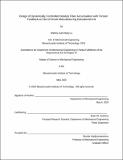| dc.contributor.advisor | Brian W. Anthony. | en_US |
| dc.contributor.author | Lu, Shirley Suet-Ning. | en_US |
| dc.contributor.other | Massachusetts Institute of Technology. Department of Mechanical Engineering. | en_US |
| dc.date.accessioned | 2020-09-03T17:48:04Z | |
| dc.date.available | 2020-09-03T17:48:04Z | |
| dc.date.copyright | 2020 | en_US |
| dc.date.issued | 2020 | en_US |
| dc.identifier.uri | https://hdl.handle.net/1721.1/127125 | |
| dc.description | Thesis: S.M., Massachusetts Institute of Technology, Department of Mechanical Engineering, May, 2020 | en_US |
| dc.description | Cataloged from the official PDF of thesis. | en_US |
| dc.description | Includes bibliographical references (pages 106-107). | en_US |
| dc.description.abstract | In the age of automation and computation, smart manufacturing is being adopted by manufacturing industries because its data-rich approach enables production of higher-quality goods at reduced costs. However, there is an associated learning curve for operators and manufacturing professionals to transition from the use of simply automated machines, since the 1970s, to the smart, interconnected machines today. Therefore, the objective of this research is to develop a desktop fiber accumulator with a dynamic controller that monitors fiber tension as part of a smart manufacturing educational kit. A Winding Loop Material Accumulator, WiLMA, is designed and tested as a machine whose main purpose is to be an effective buffer for the difference in speed between the machine upstream outputting fiber at a constant rate and the machine downstream intaking fiber at a variable rate without damaging or over-tensioning the fiber. | en_US |
| dc.description.abstract | To test the versatility of WiLMA, various operational profiles are used for the machines upstream and downstream. The upstream machine maintains a constant velocity profile, varying the ratio of the upstream machine's velocity to the downstream machine's velocity, from 1.25x to 3.0x. The downstream, variable-rate machine assumed two types of profiles: constant intake velocity, both low (10 mm/s) and high speed (40 mm/s); square wave profile for intake velocity, low (10 mm/s) and high speed (30 mm/s) as well as varying frequencies (0.1 Hz, 1.0 Hz). The force applied to the fiber by a spring-loaded tensioner acts as a proxy for the fiber tension. This tensioning force is measured, and its standard deviation and error are used to evaluate WiLMA's performance. Further testing with different fiber materials, frequencies, and speeds are necessary to validate the versatility of WiLMA. | en_US |
| dc.description.abstract | However, with the force applied to the fiber nominally set at 0.75 lbs, all trials yielded less than 0.07 lbs of average standard deviation in this tensioning force. The results suggest that WiLMA performs well as an accumulator, distinguished from industry accumulators by its ability to respond to changing conditions, while not damaging the fiber. The feedback control system and data logging allow WiLMA to be used as an educational platform for smart manufacturing. | en_US |
| dc.description.statementofresponsibility | by Shirley Suet-Ning Lu. | en_US |
| dc.format.extent | 141 pages | en_US |
| dc.language.iso | eng | en_US |
| dc.publisher | Massachusetts Institute of Technology | en_US |
| dc.rights | MIT theses may be protected by copyright. Please reuse MIT thesis content according to the MIT Libraries Permissions Policy, which is available through the URL provided. | en_US |
| dc.rights.uri | http://dspace.mit.edu/handle/1721.1/7582 | en_US |
| dc.subject | Mechanical Engineering. | en_US |
| dc.title | Design of dynamically controlled desktop fiber accumulator with tension feedback as part of smart manufacturing educational kit | en_US |
| dc.type | Thesis | en_US |
| dc.description.degree | S.M. | en_US |
| dc.contributor.department | Massachusetts Institute of Technology. Department of Mechanical Engineering | en_US |
| dc.identifier.oclc | 1191837094 | en_US |
| dc.description.collection | S.M. Massachusetts Institute of Technology, Department of Mechanical Engineering | en_US |
| dspace.imported | 2020-09-03T17:48:03Z | en_US |
| mit.thesis.degree | Master | en_US |
| mit.thesis.department | MechE | en_US |

